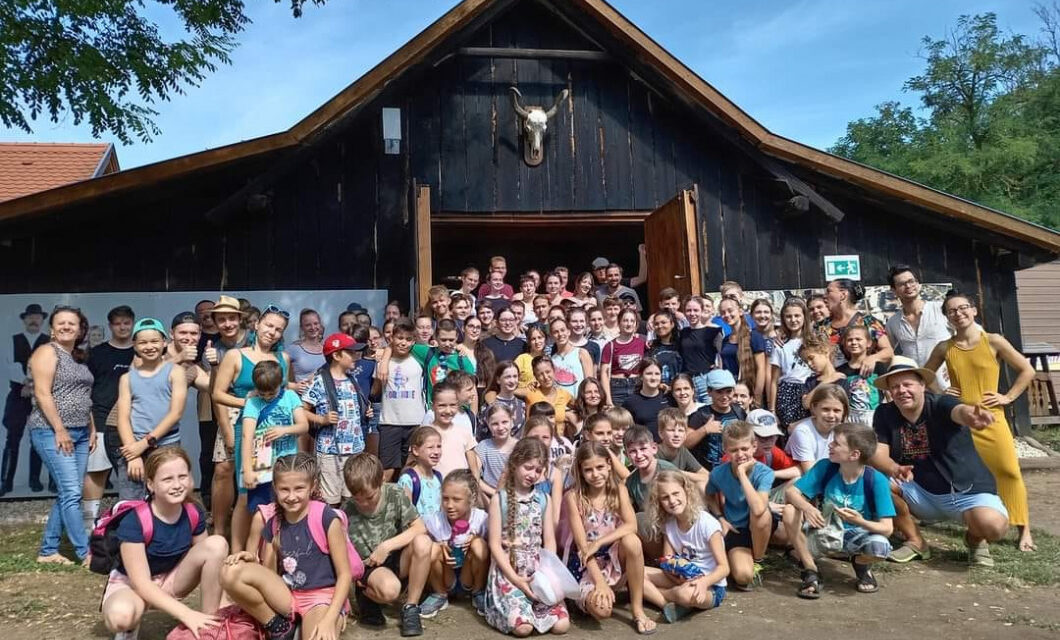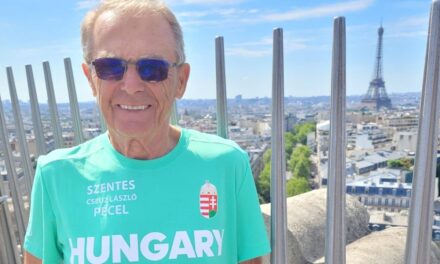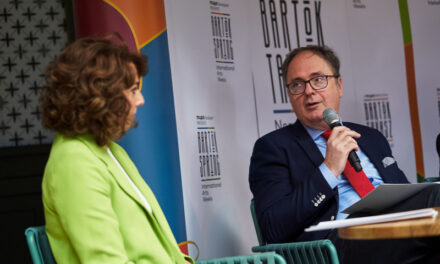Even a six-year-old can sense that the game here is not for nothing, and even if it is easy to get Kati to dance, Kati still has a lot to learn in the dance life. On-site report from the training camp of the Fitos Dezső Association.
"The skirt spins, the skirt spins" while "a couple of girls, two couples of girls" and the boys next to them are tearing their shoes in the Kiscső barn: the summer training camp of the children's and youth section of the Fitos Dezső Association is taking place, with nearly one hundred and fifty participants.
The dance crackles, the skirts rustle, the air glows in the already hot barn, but young and old alike feel that the splashing drops of sweat are not wasted: they leaven the autumn season of the folk dancing seedlings. Enikő Kocsis, Julcsi Paár and Dezső Fitos are dictating a very tight pace to the youth training for folk dance and folk song singing.
We couldn't find a warmer period in the summer than the week after August 20th, but when it comes to weather and luck, you have to be humble. And it is difficult to imagine greater humility than practicing the most intensive activity in existence, folk dance, all day long, at the command of three troupes, in such heat. There must be a person on their feet who can endure this without a shoe, and as it turned out later, on the penultimate day of the camp, which started on Monday, everyone still had the strength to burr the figures until the musicians pulled the soles.
I arrived at the camp with guests: a starry-eyed six-year-old pigtail and his grandmother accompanied me to spy. The little girl has plans for the sizzling skirt, and she came to see what learning folk dance is all about. Just at the right time, because in the preparatory camp you can really experience the intense work that precedes the dazzling spectacle on stage. Even a six-year-old can sense that the game here is not for nothing, and even if it is easy to get Kati to dance, Kati still has a lot to learn from the dance life. When we enter, the small braid is already being held by a little girl who is resting, and they watch together as Enikő and Dezső prepare to present a figure:
The children stand in a circle and watch, several of them record the "lesson" with their phones, which they soon have to "announce" by drawing in the air, using their whole bodies as playboys. The eyes will have a lot of work, and the feet will also work for the appreciative glances, but the secret of the complexity of learning to dance is still to be found in the memory.
It is especially true of folk dance that everything is decided in the head,
because it is not enough to see and remember the movements, but we also have to activate our own physical, somatic memory to be able to reproduce the figure accurately. This requires a level of concentration in which a person is active from the top of his head to the end of his toes - it is no coincidence that dance is one of the most effective therapeutic tools for various attention disorders. The folk dance has the fantastic characteristic of turning the natural movements of the body into art, while moving the dancers and the whole community from Hencida to Boncida and from porcika to porcika. And the natural movement written to an increased tempo and precise rhythm is healing for both body and soul.
This experience unites the participants of the talent development program of the Fitos Dezső Company: the Lippentő Dance Ensemble from Győr, the Szentendre Dance Ensemble and the Fonó Dance Group - both young and old - who, by learning the dance language of our ancestors, not only demonstrate their "language skills", but also learn the clean room of their souls in order. to keep
In the hundreds of children's teams, from eight-year-olds to teenagers, young people of all ages, shapes and temperaments share the experiences of the extremely intensive camp, and they can clearly handle the crease well.
"We teach dance in an ascending system: we have students from five or six years old to twenty-year-olds, and in both of our large ensembles, education takes place in three groups. Now we have brought three age groups, the youngest ones have not come with us yet, but they will be dancing here next summer too"
says Enikő.
Dezső beckons, and the countdown begins. Today they are rehearsing the summary of the week, each group will present what they have learned during the four days, for which there will also be a reward in the evening dance hall: they will be able to dance as long as their legs can take it, exceptionally there will be no distribution of pyjamas. The children welcome the news with cheers, as if they hadn't danced a single step all week. The final dance rehearsal takes place by group: Enikő and Dezső created separate choreography for all three groups, so while one group dances, the others sit around and watch them. In the meantime, they learn at least as much as when they circle the figures themselves.
The young artist couples of the Fitos Dezső Dezső Company have also been participating in the dance lessons for years: Eszter Németh, Ákos Östör, Éva Bíró, Péter Gellén and Bálint Molnár, who did the lion's share of the work in this year's camp as well. On the one hand, they taught themselves the Mezőföld, Mezőség and Moldavian dance materials, and on the other hand, by practicing dance teaching, they weave the pedagogical threads of their artistic work ever stronger.
"In addition to ensemble work, there are many other programs and activities that the dancers need to work together, and that we can achieve progress in an ascending system and put together stage choreographies in which the children feel safe. During this one week, we can practically lay the foundation for the whole year's work"
- says Enikő, who started teaching dance thirty years ago. However, this "training camp" has another, no less important function:
"In the summer camp, we can also show the folk dance in its original function, that is, the children also learn to have fun, which is not possible to experience during the dance rehearsals during the year. During the day, we try to sculpt the figures that we dance in the dance hall in the evening, that is, they use and enjoy dancing. In fact, the results of the day's work come to fruition in the evening entertainment - when they forget about studying and dance freely"
says Dezső.
Enikő and Dezső supervise the series of couple dances, circle dances and lads: sometimes from outside, from the edge of the dancing crowd, or from the middle of the circle to check the legs and improve the movements. If it's 36 degrees outside, it's 46 degrees inside, as the dancers themselves heat the otherwise draughty barn, but no one cares about that. I look through this colorful company, but I see no difference between the children. I only see what connects them: a common passion.
The folk dance has an amazing power, they hardly even notice how much self-knowledge, human knowledge, life experience and knowledge they gain in the process, and of course, with the rhythm of the couple dances, love also sneaks into the hearts.
"This camp is like the community of a village: we do everything together, and in the process we get to know each other better, we listen and take care of each other. The older ones learn to take care of the younger ones, help them, and the younger ones learn a lot from the older ones. In everyday life, many children no longer meet such a mixed community, since they study mainly in homogeneous age groups at school. Here, however, even the more difficult children begin to function, they receive an amazing boost of self-confidence simply by being able to connect with several generations so naturally. This can also be seen in their creativity: during the week, they were given several creative tasks, perhaps the biggest one being the presentation of their own choreography, which we will score and award. Now I can say from decades of experience that great works are created," says Enikő.
At a glance, you can guess that these children get more from the folk dance than just the dance experience, but Enikő also confirms this:
"The things learned in dance, and especially in dance camp, become a way of life for the children, and we already see this later, during the year, during the rehearsals. The way they come in, the way they greet each other, the way they treat each other is all an imprint of this experience. Here, for example, they forget their phones within two days, which is quite a rare phenomenon these days.
Over the decades, together with Dezső, we developed a method that we use in our own camps, and the results of which confirm that we are on the right track. We were also taken to dance camps at that time, but in those camps there were nowhere near as many personality-expanding tasks as we put in. And you see, they do it even at 40 degrees, without socks, because they enjoy it. Of course, there is also a siesta, a game, a trip, meta-analysis, drawing, a message board, pebble painting and other recreation, but in the meantime, they also create choreography, which is serious, responsible creative work that requires teamwork.
We get the kids moving at all levels, and it really pays off"
- Enikő lists the programs of the week.
The Moldavian dances that follow after field and field dances come from the easternmost ends of the Hungarian-speaking region, from Moldavia, and represent the most archaic layer not only in Hungarian but also in European dance history. In the circle dance, the shared fate and knowledge of the Balkan peoples comes to life, and preserves the imprint of ancient ceremonies. In this form, the basic experience of connection and interdependence is best fulfilled, and it is shown most clearly that every human life is a single link in the great chain of the universe. Moldovan dances are performed by all groups together:
There really isn't a wasted minute in this concentrated work, which goes into the late afternoon, and during which Julcsi Paár takes over the baton, who is taking part in the talent training camp of the Fitos Dezső Society for the first time this year: a summary of the folk songs learned this week follows.
Enikő and Dezső watch the children from the background, and I keep my ears peeled, because even though my own repertoire of folk songs is not small, I also learn something new here - for that I am especially grateful to Julcsi. The little guest girl with pigtails is listening from a yoga swing, and I can see that she really likes it all. Julcsi turns the pages of the Mezőségi Songbook and his own "program book", sings, reminds and encourages, and where necessary, acts as a potentiometer: he attracts the boys' voices. The motley choir persistently cyphers the melodies in a semicircle, and although it is already clear that they are very tired, the singing rehearsal suits them very well.
"With folk songs and singing, the child gets a tool with which he can work with himself, his emotions, his energy, and his human relationships. These are the most important things that make us human. Here, at the age of six and a half, he learns to sing and learns to feel good in a community," says Julcsi, who is closely related to Enikő and Dezső's dance teaching work not only as a performer, but also as a music therapist.
It is certain that through every danced movement and sung sound, the children will gain access to ancient, secret knowledge. They get back something from the wisdom of traditional culture, which has to be stolen back into our lives today, since we have moved so far away from our former, close-to-nature ways of life.
"They learn where they belong in the community, what their role is, they learn to take responsibility for themselves, to express themselves in front of others. A long time ago, a girl was impressed if a boy could sing, so the ability to sing and dance played a very important role in natural selection. Those who were good singers and dancers could have been poorer, but they had serious prestige in the village."
- says Julcsi, whose CDs Kerekutca and Kerekerdő fill the homes of more and more Hungarian families with joy.
After the song, the company divides into groups again, this time they go to the main rehearsal of the evening choreography presentation, in groups of 10-12 people. The stakes are not small: each production will be watched and evaluated by strict judges, and the placings - just like the skills competitions in the old village - are definitely a matter of prestige. No one took their task lightly, so the rehearsals can be heard from different corners of the yard. Meanwhile, the band responsible for the atmosphere of the evening's entertainment also arrives, and although it seems that the barn is empty, we only see the moments of the "transition".
Finally, Enikő, Julcsi and Dezső get a little breather, and as we sit around the table under the big walnut tree, I understand where the abundance of energy comes from, with which they are able to watch, take care of, and teach these many children. What they give, they get back with interest from each of them: is it any wonder that they start the next season with such a rich repertoire?
We say goodbye to Enikőtő, Julcsi and Dezsőtő, as well as the dancers preparing for the evening program, and we head home with the star-eyed pigtail and the grandmother. The scorching heat didn't spare us either, so we freshen up a bit in the car. It's almost a two and a half hour drive to our home country, but I know it's not wasted time, because the little girl I brought with me as a guest is not disappointed: her braided hair will be flying around in Fono from September. It's so easy to ask for a folk dance, if you have someone to show your true power.
Featured image: Dezső Fitos Company













